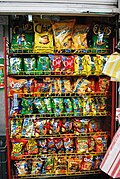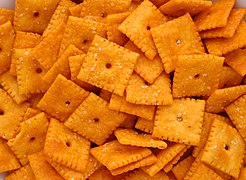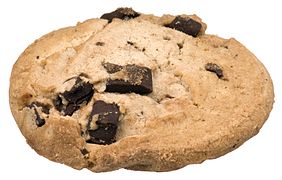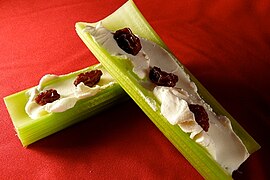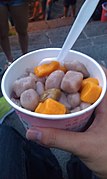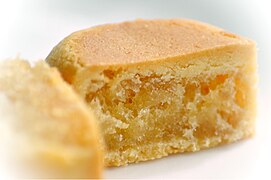Snack
The examples and perspective in this article may not represent a worldwide view of the subject. (March 2009) |
| Part of a series on |
| Meals |
|---|
 |
| Meals |
|
| Components and courses |
|
| Related concepts |
|

A snack is a small portion of food generally eaten between meals.[1] Snacks come in a variety of forms including packaged snack foods and other processed foods, as well as items made from fresh ingredients at home.
Traditionally, snacks are prepared from ingredients commonly available at home without a great deal of preparation. Often cold cuts, fruits, leftovers, nuts, sandwiches, and sweets are used as snacks. With the spread of convenience stores, packaged snack foods became a significant business.
Snack foods are typically designed to be portable, quick, and satisfying. Processed snack foods, as one form of convenience food, are designed to be less perishable, more durable, and more portable than prepared foods. They often contain substantial amounts of sweeteners, preservatives, and appealing ingredients such as chocolate, peanuts, and specially-designed flavors (such as flavored potato chips).
Beverages, such as coffee, are not generally considered snacks although they may be consumed along with or in lieu of snack foods.[2]
A snack eaten shortly before going to bed or during the night may be called a "bedtime snack", "late night snack", or "midnight snack".
Snacks in the United States[]
In the United States, a popular snack food is the peanut. Peanuts first arrived from South America via slave ships and became incorporated into African-inspired cooking on southern plantations. After the Civil War, the taste for peanuts spread north, where they were incorporated into the culture of baseball games and vaudeville theaters.[3]
Along with popcorn (also of South American origin), snacks bore the stigma of being sold by unhygienic street vendors. The middle-class etiquette of the Victorian era (1837–1901) categorized any food that did not require proper usage of utensils as lower-class.[3]
Pretzels were introduced to North America by the Dutch, via New Amsterdam in the 17th century. In the 1860s, the snack was still associated with immigrants, unhygienic street vendors, and saloons. Due to loss of business during the Prohibition era (1920-1933), pretzels underwent rebranding to make them more appealing to the public. As packaging revolutionized snack foods, allowing sellers to reduce contamination risk, while making it easy to advertise brands with a logo, pretzels boomed in popularity, bringing many other types of snack foods with it. By the 1950s, snacking had become an all-American pastime, becoming an internationally recognized emblem of middle American life.[3][4]
Snacks in East Asia[]
Indonesia[]
Kue[]
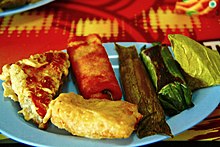
Indonesia has a rich collection of snacks called kue (cakes and pastry), both savoury and sweet. Traditional kue is usually made from rice flour, coconut milk, and coconut sugar, and is mostly steamed or fried rather than baked. Traditional kue are popularly known as kue basah ("wet kue") that has a moist, soft texture because of rich coconut milk. Kue kering (dried kue) is the local name for cookies. Indonesia has several variations of kue, both native and foreign-influenced.[citation needed]
Traditional crackers[]

Traditional crackers are called krupuk, made from bits of shrimp, fish, vegetables or nuts, which are usually consumed as a crunchy snack or an accompaniment to meals.[5] These crispy snacks are sometimes added to main dishes for their crunchy texture; several Indonesian dishes such as gado-gado, karedok, ketoprak, lontong sayur, nasi uduk, asinan and bubur ayam are known to require specific types of krupuk as toppings. There are wide variations of krupuk available across Indonesia. The most popular ones would be krupuk udang (prawn crackers) and krupuk kampung or krupuk putih (cassava crackers).[citation needed]
Other popular types include krupuk kulit (dried buffalo-skin crackers), emping melinjo (gnetum gnemon crackers), and kripik (chips/crisps), such as kripik pisang (banana chips) and keripik singkong (Cassava chips). Rempeyek is a flour-based cracker with brittle of peanuts, anchovies or shrimp bound by a crispy flour cracker. Rengginang or intip (Javanese) is a rice cracker made from sun-dried and deep fried leftover rice.[citation needed]
Japan[]
Japan has a very wide range of snack foods ranging from onigiri to Melon pan. For more details see List of Japanese snacks and Japanese cuisine.[citation needed]
Malaysia[]
- Cincin - a deep fried dough pastry-based snack popular with East Malaysia's Muslim communities.[citation needed]
- Roti john - a spiced meat omelette sandwich, popularly eaten for breakfast or as a snack.[citation needed]
- Bakkwa (Chinese : 肉干) - literally "dried meat", bakkwa is better understood as barbecued meat jerky. While this delicacy is especially popular during the Chinese New Year celebration period, it is available everywhere and eaten year round as a popular snack.[citation needed]
- Idli - made from a mashed mixture of skinned black lentils and rice formed into patties using a mould and steamed, idlis are eaten at breakfast or as a snack. Idlis are usually served in pairs with vadai, small donut-shaped fritters made from mashed lentils and spices, chutney, and a thick stew of lentils and vegetables called sambar.[citation needed]
- Murukku - a savoury snack of spiced crunchy twists made from rice and urad dal flour, traditionally eaten for Deepavali in South India.[citation needed]
- Vadai, vada or vades - is a common term for many different types of savoury fritter-type snacks originated from South India with a set of common ingredients. The most common ingredients are lentils, chillis, onions, and curry leaves.[citation needed]
- Tebaloi - is a sago biscuit snack which is traditionally associated with the Melanau people of Sarawak.[6]
- Pisang goreng - a common snack sold by street vendors, battered fried bananas are also served in a more elaborate manner at some cafes and restaurants as a dessert. Cempedak and various tuber vegetables are also battered and fried in the same manner as variations.[citation needed]
Taiwan[]
- Taro ball - a traditional Taiwanese cuisine dessert made of taro.
- Suncake (Taiwan) - is a popular Taiwanese dessert originally from the city of Taichung, Taiwan.
- Aiyu jelly - is a jelly made from the gel from the seeds of the awkeotsang creeping fig found in Taiwan.
- Pineapple cake - is a sweet traditional Taiwanese pastry containing butter, flour, egg, milk powder, sugar, and pineapple paste or slices.
Thailand[]
- Miang kham – dried shrimp and other ingredients wrapped in cha plu leaves; often eaten as a snack or a starter.[citation needed]
- Sai ua – a grilled sausage of ground pork mixed with spices and herbs; it is often served with chopped fresh ginger and chilies at a meal. It is sold at markets in Chiang Mai as a snack.[citation needed]
Snacks in the Middle East[]


In the Middle East, one of the most important snacks that contains a huge amount of proteins is Lupinus, commonly known as lupin.[7][8][9] Lupin contains around 33-40% protein.[7] Another common snack in the Middle East is hummus made of chickpeas.
Snacks and nutrition[]
Government bodies, such as Health Canada, recommend that people make a conscious effort to eat more healthy, natural snacks, such as fruit, vegetables, nuts, and cereal grains while avoiding high-calorie, low-nutrient junk food.[10]
A 2010 study showed that children in the United States snacked on average six times per day, approximately twice as often as American children in the 1970s.[11] This represents consumption of roughly 570 calories more per day than U.S. children consumed in the 1970s.[12]
Types of snack foods[]
- Almonds
- Apple slices
- Bagel with cream cheese
- Bitterballen
- Candy bar
- Carrot Chips
- Cashews
- Chaat
- Cheese, a larger cold prepared snack
- Cheese puffs/cheese curls
- Chocolate-coated marshmallow treats
- Corn chips and Tortilla chips
- Cocktail sausage
- Cookies
- Crackers
- Deviled eggs
- Doughnuts
- Dried fruits
- Drinkable yogurt
- Edamame, fresh or dried
- Granola bars
- Falafel
- Flour tortilla with a filling
- Frozen berries
- Fruit cocktail
- Fruit salad
- Ice cream
- Jell-O
- Jerky
- Kaassoufflé
- Milkshake
- Pound cake, in slices
- Lunchables
- Mixed nuts
- Muffins
- Papadum
- Peanuts
- Pita bread, straight from the packet or toasted
- Popcorn
- Pork rinds
- Potato chips
- Pakoda
- Pretzels, hard or soft
- Raisins
- Ratatouille, served cold, a larger cold prepared snack
- Rice cake
- Rice crackers, distinguished from the above
- Saltines
- Samosa
- Seeds (sunflower or seed mix)
- Shortbread
- Sliced fruit
- Smoked salmon
- Smoothie
- Teacake
- Trail mix
- Vegetables (e.g., carrots, celery, cherry tomatoes)
- Whole fruit
- Yogurt
Image gallery[]

Irachikkaya
A rack of snack foods

Popcorn
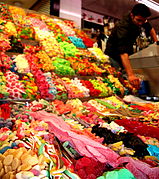
Candy
A candy bar of the Snickers brand

Potato chips
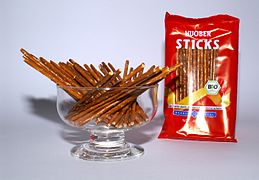
Pretzels

Doughnuts

A blueberry muffin

Peanuts
See also[]
- Canapés
- Junk food
- List of brand name snack foods
- List of foods
- List of Indian snack foods
- List of Indonesian snacks
- List of Japanese snacks
- List of snack foods
- List of snack foods by country
- Savoury (dish)
References[]
- ^ "Snack". Dictionary.com. Retrieved 13 March 2011.
- ^ Lat, Jeff (7 September 2015). "Sweet Snacks". Blogspot.com. Retrieved 19 June 2016.
- ^ Jump up to: a b c Carroll, Abigail (30 August 2013). "How Snacking Became Respectable". Wall Street Journal. ISSN 0099-9660. Retrieved 29 May 2016.
- ^ "America: just one long snack bar". Ellensburg Daily Record. 3 April 1973. Retrieved 14 December 2018 – via Google News.
- ^ Heinz Von Holzen; Lother Arsana (2015). Food of Indonesia: Delicious Recipes from Bali, Java and the Spice Islands. Tuttle Publishing. ISBN 9781462914913.
- ^ "The making of Tebaloi". Sarawak Tourism Board. Retrieved 7 June 2015.
- ^ Jump up to: a b Joray, M. L.; Rayas‐Duarte, P.; Mohamed, A.; Santen, E. Van (2007). "Coated Lupin Bean Snacks*". Journal of Food Quality. 30 (2): 267–279. doi:10.1111/j.1745-4557.2007.00120.x. ISSN 1745-4557.
- ^ "Lupini Beans, Traditional Middle-Eastern Snack Food RECIPE - Green Prophet". 5 April 2013. Retrieved 2 November 2020.
- ^ Drummond, C. S. (2012). "Multiple continental radiations and correlates of diversification in Lupinus (Leguminosae): Testing for key innovation with incomplete taxon sampling". Systematic Biology. 61 (3): 443–60. doi:10.1093/sysbio/syr126. PMC 3329764. PMID 22228799.
- ^ "Smart Snacking - Canada's Food Guide". Health Canada. Retrieved 13 March 2011.
- ^ "New Trend Shows Kids Snacking Every Few Hours". NPR.org. Retrieved 11 March 2010.
- ^ "American Diet Then and Now: How Snacking Is Expanding the Country's Waistline - ABC News". ABC News. Retrieved 20 February 2016.
| Wikimedia Commons has media related to Snack food. |
| Wikibooks Cookbook has a recipe/module on |
- Meals
- Convenience foods
- Snack foods


